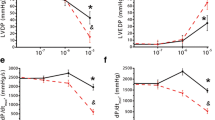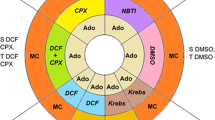Abstract
The aim of the study was to find out whether, and if so through which receptors, nucleotides modulate the release of noradrenaline in the rat pancreas. Segments of the pancreas were preincubated with [3H]-noradrenaline, superfused with medium containing desipramine (1μM) and yohimbine (1μM), and stimulated electrically, in most experiments by 60 pulses/1Hz.
The adenosine A1-receptor agonist N6-cyclopentyl-adenosine (CPA; EC50 32nM), the non-subtype-selective adenosine receptor agonists adenosine (EC50 15μM) and 5’-N-ethylcarboxamidoadenosine (NECA; EC50 135nM), and the nucleotides ATP (EC50 13μM), adenosine-5’-O-(3-thiotriphosphate) (ATPγS; EC50 19μM) and adenosine-5’-O-(2-thiodiphosphate) (ADPβS; EC50 16μM) decreased the evoked overflow of tritium. The adenosine A2A-agonist 2-p-(2-carboxyethyl)-phenethylamino-5’-N-ethylcarboxamido-adenosine (CGS 21680) caused no change. The concentration-response curve of CPA was shifted to the right by the A1-antagonist 8-cyclopentyl-1,3-dipropylxanthine (DPCPX 10nM; pKd 9.1) but, like the concentration-response curve of adenosine, hardly affected by the P2-receptor antagonist cibacron blue 3GA (30μM). Combined administration of a high concentration of DPCPX (1μM) and 8-phenyltheophylline (10μM) abolished the effects of CPA and NECA. The concentration-response curves of ATP and ADPβS were shifted to the right by both DPCPX (10nM; pKd 8.7 and 8.9, respectively) and cibacron blue 3GA (30μM; pKd 5.0 and 5.2, respectively). The antagonist effects of DPCPX (10nM) and cibacron blue 3GA (30μM) against ATP were additive in a manner compatible with the blockade of two separate receptors for ATP. In the presence of the high concentration of DPCPX (1μM) and 8-phenyltheophylline (10μM), ATP and ADPβS still decreased evoked tritium overflow, and this decrease was attenuated by additional administration of cibacron blue 3GA (30μM). The P2-antagonists cibacron blue 3GA, reactive blue 2, reactive red 2, and to a limited extent also suramin and 8-(3,5-dinitro-phenylenecarbonylimino)-1,3,5-naphthalenetrisulphonate (XAMR0721), increased the evoked overflow of tritium by up to 114%. Pyridoxalphosphate-6-azophenyl-2’,4’-disulphonate (PPADS) caused no change. The results indicate that the postganglionic sympathetic axons of the rat pancreas possess A1-adenosine and P2-receptors. Both receptors mediate an inhibition of noradrenaline release. The presynaptic P2-receptors are activated by an endogenous ligand, presumably ATP, during appropriate trains of action potentials. This is the first demonstration of presynaptic P2-receptors at postganglionic sympathetic neurons that are located in prevertebral ganglia.
Similar content being viewed by others
Author information
Authors and Affiliations
Additional information
Received: 6 November 1997 / Accepted: 6 January 1998
Rights and permissions
About this article
Cite this article
Koch, H., von Kügelgen, I. & Starke, K. P2-Receptor-mediated inhibition of noradrenaline release in the rat pancreas. Naunyn-Schmiedeberg's Arch Pharmacol 357, 431–440 (1998). https://doi.org/10.1007/PL00005190
Issue Date:
DOI: https://doi.org/10.1007/PL00005190




